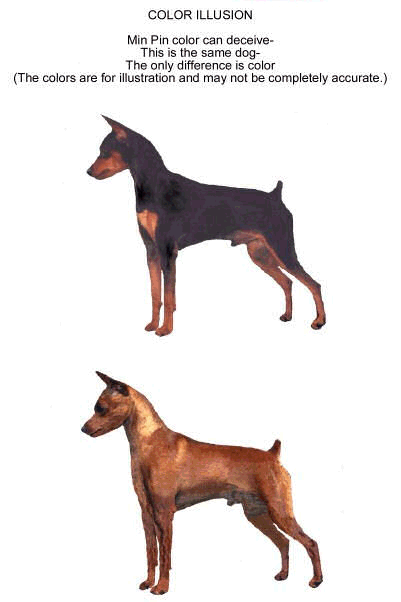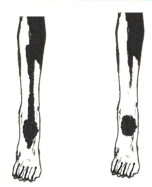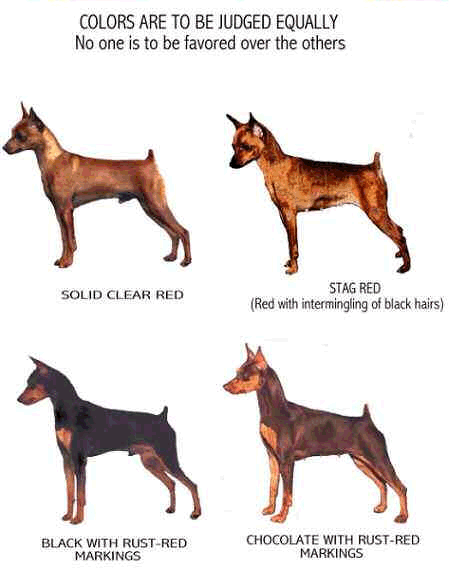COAT
AKC Standard:
Coat – Smooth, hard and short, straight and lustrous, closely adhering to and uniformly covering the body.
Discussion:
Some Min Pins naturally have very thin hair covering the throat and/or underbelly, even though the coat is thicker on other areas. This is very common and should not be penalized. In order to present a smooth clean appearance for the show ring, Min Pins often have whiskers removed and excess hair trimmed around the ears, tuck-up and breech areas. Whisker removal is not required.
COLOR
AKC Standard:
Color – Solid clear red. Stag red (red with intermingling of black hairs). Black with sharply defined rust-red markings on cheeks, lips, lower jaw, throat, twin spots above eyes and chest, lower half of fore legs, inside of hind legs and vent region, lower portion of hocks and feet. Black pencil stripes on toes. Chocolate with rust-red markings the same as specified for blacks, except brown pencil stripes on toes. In the solid red and stag red, rich vibrant, medium to dark shade is preferred.
DISQUALIFICATIONS:
Any color other than listed. Thumb mark (patch of black hair surrounded by rust on the front of the foreleg between the foot and the wrist; (on chocolates, the patch is chocolate hair). White on any part of dog which exceeds one half inch in its longest dimension.
Discussion:
It is important to remember that all colors must be judged equally; no one is to be favored over the others. Note that the broken color pattern of the black & rust-red and chocolate & rust-red Min Pins often present an optical illusion that make them appear to be of lesser quality than the solid red dogs, even though this is not really the case. For example, upon cursory examination, the head of a black & rust-red Min Pin may appear to be broader than the identical head on a red dog. Conversely, the black & rust-red Min Pin may appear more refined than his red counterpart. Careful observation is necessary to accurately assess the broken-color dogs.

The markings of the black & rust-red Min Pin, described in the Standard, are typical of those of other black with “tan points” breeds. ( In chocolate & rust-red Min Pins, substitute “chocolate” where “black” is used in this discussion.) Deviations commonly seen are double rosettes on the chest and “extensions” on the forelegs, black running down the leg, sometimes all the way to the toes. Pencil stripes (line of black hair on top of toes) are desirable, but are seen less often today than in the past. An almost total lack of markings, in which the dog appears to be almost solid black, is undesirable. Thumb marks, a disqualification, may be misunderstood. Quite simply, a thumb mark is a patch, or island, of black hair on the fron of the foreleg between the foot and the wrist that is TOTALLY surrounded by rust-red. If the black hair on the leg is in any way connected to the black on the upper part of the leg, it is an extension as described above and is NOT a disqualification, but a deviation from correct markings.
| An “extension not a disqualification |  |
A disqualifying thumbmark |
Judges should be aware that in the solid red Min Pin lighter shading or “brisking” is often seen on the side of the neck, below the base of the ears, over the shoulder blades and near the vent region. This is completely acceptable, and should not be penalized. The stag-red Min Pin always has black guard hairs, which create an “overlay” often over the back like a saddle. The amount of black hairs varies from very few to covering almost the entire dog. The amount and placement of these black hairs in not important. Although Min Pins are a single coated breed, the black & rust-red may have some gray undercoat showing on the side of the neck; this is not to be penalized. White, which exceeds 1/2 inch in its longest dimension is a disqualification, but a scattering of white hair or “frost” seen on the chest is a deviation, not a disqualification.

